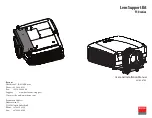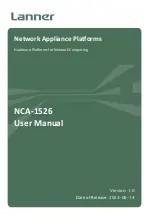
ICP
FORCE SENSOR OPERATION MANUAL
6
Figure 12 - Cable Strain Relief
FORCE RING INSTALLATION
The sensor is mounted using the supplied mounting stud and
pilot bushing. The supplied beryllium copper (BeCu) stud is
elastic so it allows force transmission to the sensor while
holding the sensor in place. The pilot bushing centers the sensor
about the mounting stud. After installing the mounting stud in
the lower of the two surfaces, the pilot bushing is threaded over
the mounting stud. The sensor is then placed over the stud and
pilot bushing combination. The pilot bushing should fit loosely
inside of the sensor inner diameter, holding it in place. Properly
machined holes for the mounting stud will ensure proper
vertical orientation of the sensor. The upper surface should be
installed and tightened onto the mounting stud. Refer to the
installation drawing for additional mounting details.
When installing the sensor as an integrated member, it is
recommended that the supplied antifriction washers be used to
eliminate the possibility of damage to the sensing surface of the
sensor. This type of damage may occur when imperfections in
the mounting surface grind against the sensor surface while the
mounting surfaces are being twisted during installation. Refer
to the installation drawing for additional mounting details.
PRELOAD REQUIREMENTS FOR FORCE RING AND
3-COMPONENT FORCE SENSORS
PCB ICP
Force Rings (Models 201B01 through 207C) and 3-
Component Force Sensors (Models 260A01 through A03) are
generally installed between two parts of a test structure, as
shown in
Figure 4
. During installation, the sensor should be
pre-loaded to the amount specified on the specification sheet
using the supplied elastic beryllium-copper stud. Preloading in
this arrangement ensures that the sensor will perform as
calibrated and have good output linearity at the sensor
’
s lower
operating range. Use of a mounting stud of stiffer material or
no stud will alter PCB calibrated sensitivity.
The stud or bolt holds the structure together and applies preload
to the force ring as shown in
Figure 13
. In the typical link
installation, shown on the left in
Figure 13
, part of the force
between the two structures is shunted through the mounting
stud. The amount of force shunted is dependent on the stud
material, but may be up to 5% of the total force for the
beryllium-copper stud supplied with the sensor and up to 50%
for steel studs. This typical installation setup is used by PCB
during standard calibrations of force ring models 201B01
through 207C. PCB’s standard calibration, when using the
BeCu stud, takes this shunted force into account with the final
calibration value.
A non-typical installation is shown on the right side of
Figure
13
. In this installation, the stud or bolt used to apply the preload
does not shunt part of the applied force. The plate on top of the
sensor has a clearance hole that the stud or bolt passes through.
In this installation, the stud or bolt is not directly connected to
the top plate by its threads, as it is in the typical installation, so
it does not shunt any force. This method of installation
accommodates mounting a group of sensors under a common
plate.
NOTE: If any of the following conditions apply to the
preloading of the force ring in the actual application, the
sensitivity and linearity performance of the sensor will not
match the standard PCB calibration values.
1.
Use of a stud or bolt other than the supplied beryllium-
copper stud.
2.
Use of no stud or bolt.
3.
Use of an amount of preload other than the
recommended amount.
4.
Use of installation that is different from PCB setup
during calibration.
5.
On rare occasions, a ring sensor may be installed
WITHOUT a mounting stud (as installed in precise
fixture). In these cases, the sensor sensitivity will be
HIGHER than that shown on the PCB calibration
certificate.
In these cases, please contact a PCB applications engineer at
800-828-8840 of the intended installation to discuss your
special calibration requirements.
PCB can calibrate the
sensor without a stud OR ask that a customer supplied
mounting stud be provided for use in PCB’s calibration
process.
Figure 13 - Force Ring Sensor Installations
PCB in-house calibration procedure requires the installation of
a force ring with BeCu stud, in the typical installation setup
above. This sensor is then placed in series with a NIST
Typical Link Installation
Non-Typical Installation
Used for Force Limited
Vibration Testing



































